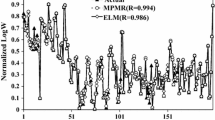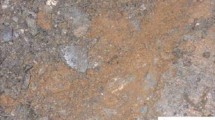Abstract
The determination of seismic liquefaction potential of soil is an important task in geotechnical engineering. This article uses Minimax Probability Machine (MPM) for determination of seismic liquefaction potential of soil based on Standard Penetration Test value (N). MPM is developed based on the use of hyperplanes. It is a discriminant classifier. This study uses MPM as a classification tool. MPM uses the database collected from Chi–Chi earthquake. Two models (MODEL I and MODEL II) have been developed. MODEL I uses Cyclic Stress Ratio and N as input variables. Peck Ground Acceleration and N have been adopted as inputs for MODEL II. The performance of MODEL I and MODEL II are 97.67 and 96.51 % respectively. The performance of MODEL II is 94.11 % for the global data. The developed MPM shows good generalization capability. The results show that the developed MPM has ability for determination of seismic liquefaction potential of soil.




Similar content being viewed by others
References
Andrus RD, Stokoe KH (2000) Liquefaction resistance of soils from shear wave velocity. J Geotech Geoenviron Eng ASCE 126(11):1015–1025
Goh ATC (1994) Seismic liquefaction potential assessed by neural network. J Geotech Geoenviron Eng 120(9):1467–1480
Goh ATC (1996) Neural-network modeling of CPT seismic liquefaction data. J Geotech Eng 122(1):70–73
Goh ATC, Goh SH (2007) Support vector machines: their use in geotechnical engineering as illustrated using seismic liquefaction data. Comput Geotech 34(5):410–421
Hwang JH, Yang CW (2001) Verification of critical cyclic strength curve by Taiwan Chi-Chi earthquake data. Soil Dyn Earthq Eng 21:237–257
Javadi AA, Rezania M, Nezhad MM (2006) Evaluation of liquefaction induced lateral displacements using genetic programming. Comput Geotech 33:222–233
Kayadelen C (2011) Soil liquefaction modeling by genetic expression programming and neuro-fuzzy. Expert Syst Appl 38(4):4080–4087
Kecman V (2001) Learning and soft computing: support vector machines, neural networks, and fuzzy logic models. MIT press, Cambridge
Lanckriet G, El Ghaoui L, Jordan M (2003) Robust novelty detection with single-class MPM. In: Becker S, Thrun S, Obermayer K (eds) Advances in neural information processing systems 15. MIT Press, Cambridge
Najjar YM, Ali HE (1998) CPT-based liquefaction potential assessment: a neuronet approach. Geotech Spec Publ ASCE 1:542–553
Pal M (2006) Support vector machines-based modelling of seismic liquefaction potential. Int J Num Anal Methods Geomech 30:983–996
Park D, Rilett LR (1999) Forecasting freeway link ravel times with a multi-layer feed forward neural network. Comput Aid Civil Infrastruct Eng 14:358–367
Robertson PK, Campanella RG (1983) Interpretation of cone penetration tests. Part I: sand. Can Geotech J 20(4):718–733
Samui P (2007) Seismic liquefaction potential assessment by using relevance vector machine. Earthq Eng Eng Vib 6(4):331–336
Samui P (2008) Support vector machine applied to settlement of shallow foundations on cohesionless soils. Comput Goetech 35(3):419–427
Samui P (2011) Least square support vector machine and relevance vector machine for evaluating seismic liquefaction potential using SPT. Nat Hazards 59(2):811–822
Seed HB, Idriss IM (1967) Analysis of soil liquefaction: Niigata earthquake. J Soil Mech Found Div ASCE 93(3):83–108
Seed HB, Idriss IM (1971) Simplified procedure for evaluating soil liquefaction potential. J Soil Mech Found Div ASCE 97(9):1249–1273
Seed HB, Idriss IM, Arango I (1983) Evaluation of liquefaction potential using field performance data. J Geotech Eng Div ASCE 109(3):458–482
Seed HB, Tokimatsu K, Harder LF, Chung RM (1984) Influence of SPT procedures in soil liquefaction resistance evaluation. Rep.No. UCB/EERC-84/15 Earthquake Engrg. Res. Ctr., Univ. of California, Berkeley, California
Sun J, Bai Y, Luo J, Dang J (2009) Modelling of a chaotic time series using a modified minimax probability machine regression. Chin J Phys 47(4):491–501
Vapnik VN (1998) Statistical learning theory. Wiley, New York
Yang L, Wang L, Sun Y, Zhang R (2010) Simultaneous feature selection and classification via minimax probability machine. Int J Comput Intell Syst 3(6):754–760
Youd TL, Idriss IM, Andrus RD, Arango I, Castro G, Christian JT, Dobry R, Finn WDL, Harder LF Jr, Hynes ME, Ishihara K, Koester JP, Liao SSS, Marcuson WF III, Martin GR, Mitchel JK, Moriwaki Y, Power MS, Robertson PK, Seed RB, Stokoe HKH (2001) Liquefaction resistance of soils: summary report from the 1996 NCEER and 1998 NCEER/NSF workshops on evaluation of liquefaction resistance of soils. J Geotech Geoenviron Eng ASCE 127(10):817–833
Young K, Byung Tak K (2006) Use of artificial neural networks in the prediction of liquefaction resistance of sands. J Geotech Geoenviron Eng 132(11):502–1504
Zhou Z, Wang Z, Sun X (2013) Face recognition based on optimal kernel minimax probability machine. J Theor Appl Inf Technol 48(3):1645–1651
Author information
Authors and Affiliations
Corresponding author
Rights and permissions
About this article
Cite this article
Samui, P., Hariharan, R. Modeling of SPT Seismic Liquefaction Data Using Minimax Probability Machine. Geotech Geol Eng 32, 699–703 (2014). https://doi.org/10.1007/s10706-014-9749-4
Received:
Accepted:
Published:
Issue Date:
DOI: https://doi.org/10.1007/s10706-014-9749-4




